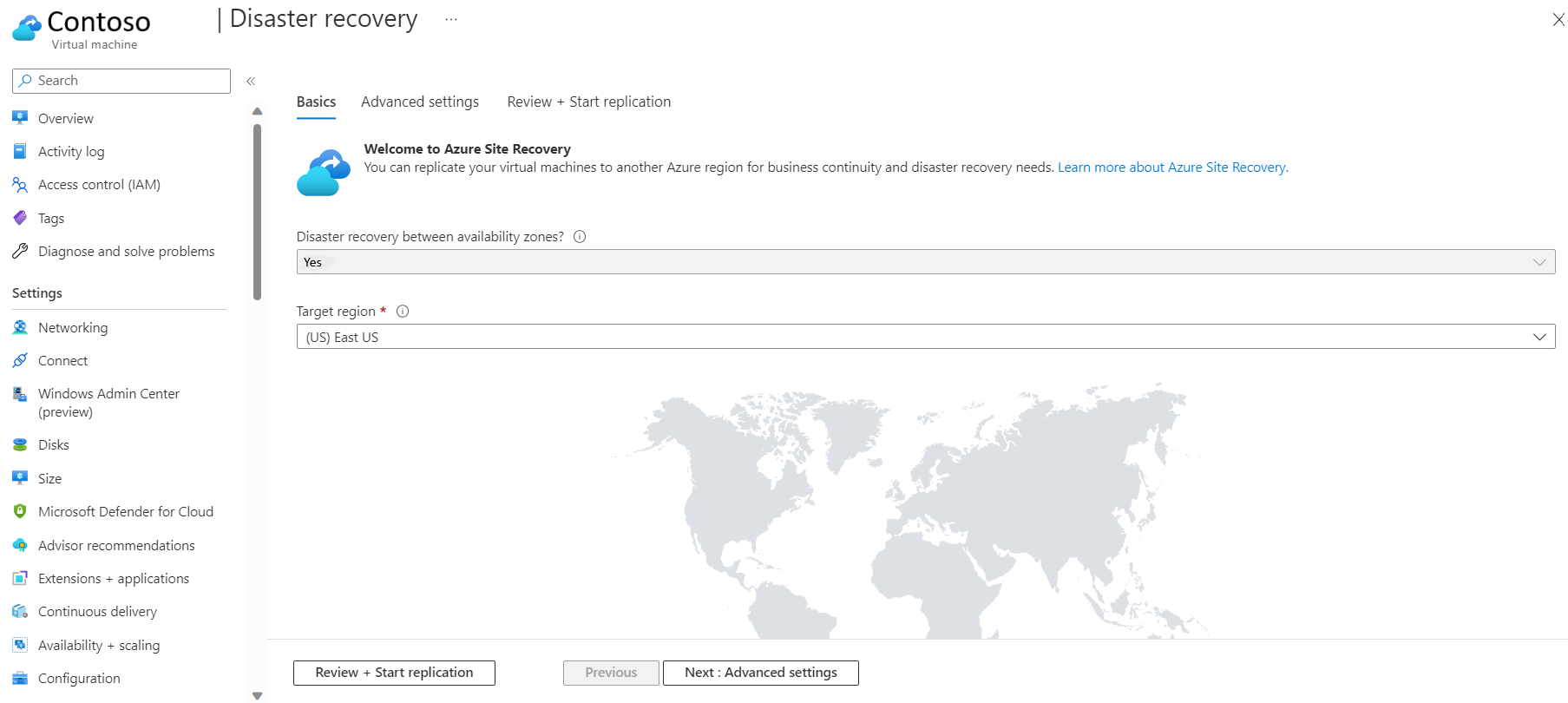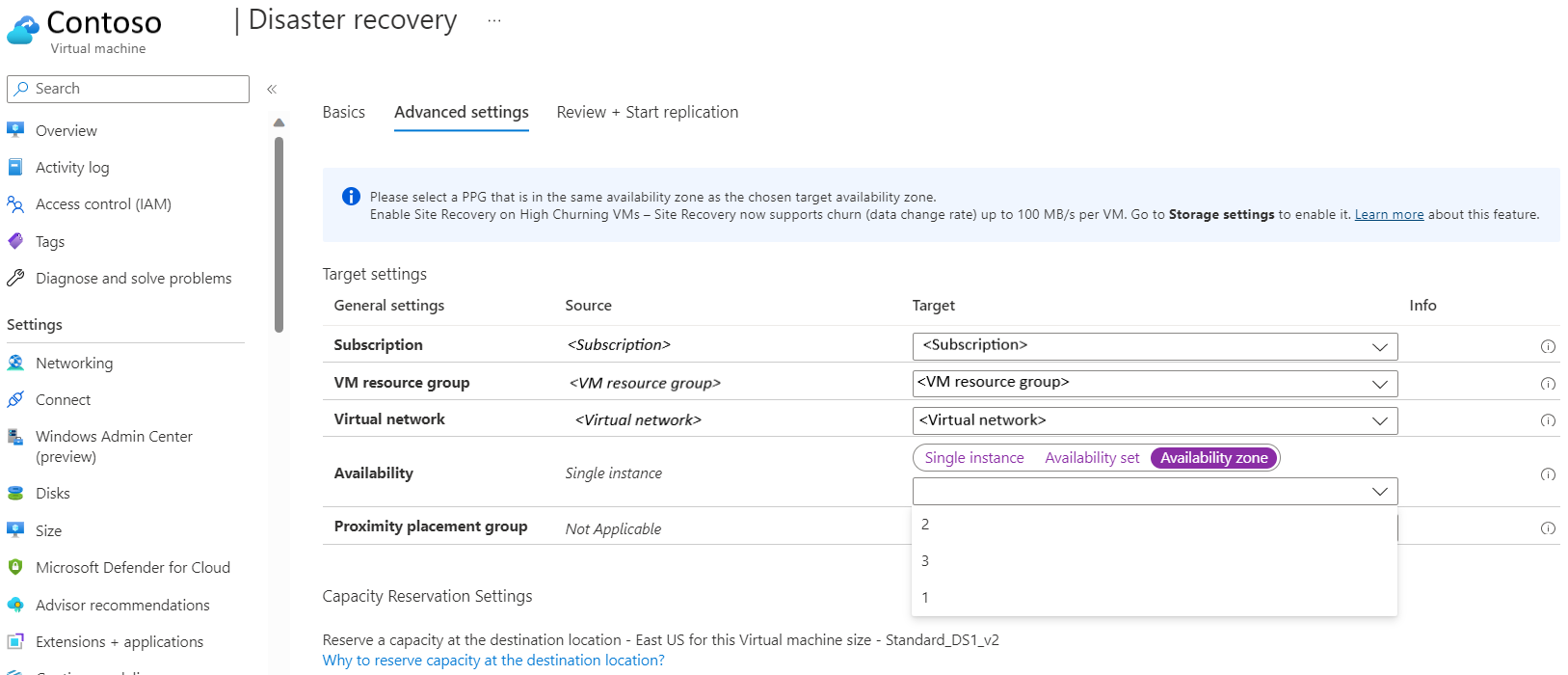Enable Azure VM disaster recovery between availability zones
This article describes how to replicate, fail over, and fail back Azure virtual machines (VMs) from one availability zone to another within the same Azure region.
The Azure Site Recovery service can contribute to your strategy for business continuity and disaster recovery by keeping your business apps running during planned and unplanned outages. We recommend Site Recovery as the disaster recovery option to keep your applications running if there are regional outages.
Availability zones are unique physical locations within an Azure region. Each zone has one or more datacenters.
If you want to move VMs to an availability zone in a different region, review this article.
Supported regions for zone-to-zone disaster recovery
Support for zone-to-zone disaster recovery is currently limited to the following regions:
| Americas | Europe | Middle East | Africa | Asia Pacific |
|---|---|---|---|---|
| Brazil South | France Central | Israel Central | South Africa North | Australia East |
| Canada Central | Germany West Central | Qatar Central | Central India | |
| Central US | Italy North | UAE North | China North 3 | |
| East US | North Europe | East Asia | ||
| East US 2 | Norway East | Japan East | ||
| South Central US | Poland Central | Korea Central | ||
| US Gov Virginia | Sweden Central | Southeast Asia | ||
| West US 2 | Switzerland North | |||
| West US 3 | UK South | |||
| West Europe |
When you use zone-to-zone disaster recovery, Site Recovery doesn't move or store data out of the region in which it's deployed. You can select a Recovery Services vault from a different region if you want one. The Recovery Services vault contains metadata but no actual customer data.
Learn more about Azure regions with availability zones.
Note
Zone-to-zone disaster recovery isn't supported for VMs that have managed disks via zone-redundant storage (ZRS).
Regions that don't support Azure availability zones also don't support Azure Site Recovery zone-to-zone replication. For Azure Site Recovery zone-to-zone replication to work, the region must support availability zones.
Using availability zones for disaster recovery
Typically, customers use availability zones to deploy VMs in a high-availability configuration. Those VMs might be too close to each other to serve as a disaster recovery solution in natural disaster.
However, in some scenarios, customers can use availability zones for disaster recovery:
- Customers who had a metro disaster recovery strategy while hosting applications on-premises sometimes want to mimic this strategy after they migrate applications to Azure. These customers acknowledge that a metro disaster recovery strategy might not work in a large-scale physical disaster, and they accept this risk. Such customers can use zone-to-zone disaster recovery.
- Many customers have complicated networking infrastructure and don't want to re-create it in a secondary region because of the associated cost and complexity. Zone-to-zone disaster recovery reduces complexity. It uses redundant networking concepts across availability zones to make configuration simpler. Such customers prefer simplicity and can also use availability zones for disaster recovery.
- In some regions that don't have a paired region within the same legal jurisdiction (for example, Southeast Asia), zone-to-zone disaster recovery can serve as the disaster recovery solution. It helps ensure legal compliance, because applications and data don't move across national boundaries.
- Zone-to-zone disaster recovery implies replication of data across shorter distances when compared with Azure-to-Azure disaster recovery. It can reduce latency and therefore reduce recovery point objective (RPO).
Although these are strong advantages, there's a possibility that zone-to-zone disaster recovery can fall short of resilience requirements in the event of a region-wide natural disaster.
Networking for zone-to-zone disaster recovery
As mentioned before, zone-to-zone disaster recovery uses redundant networking concepts across availability zones to reduce complexity. The behavior of networking components in the zone-to-zone disaster recovery scenario is outlined as follows:
- Virtual network: You can use the same virtual network as the source network for actual failovers. For test failovers, use a virtual network that's different from the source virtual network.
- Subnet: Failover into the same subnet is supported.
- Private IP address: If you're using static IPs, you can use the same static IPs for the failed over VM once failover completes. Ensure the source VM’s private IP is static before enabling Site Recovery. You must have a free IP (different from the source IP) in the same subnet. When failover is triggered, Site Recovery assigns the free IP to the source VM, freeing the source IP so that it can be associated with target VM.
Note
You can use the same source IP for the target VM only if you choose to shut down the source VM during failover. Shutting down the VM helps to dissociate the original IP from source VM so that it can be associated with target VM.
- Accelerated networking: Similar to Azure-to-Azure disaster recovery, you can enable accelerated networking if the VM type supports it.
- Public IP address: You can attach a previously created standard public IP address in the same region to the target VM. Basic public IP addresses don't support scenarios related to availability zones.
- Load balancer: A standard load balancer is a regional resource, so the target VM can be attached to the back-end pool of the same load balancer. A new load balancer isn't required.
- Network security group: You can use the same network security groups that you applied to the source VM.
Prerequisites
Before you deploy zone-to-zone disaster recovery for your VMs, ensure that other features enabled on the VMs are interoperable with it.
| Feature | Support statement |
|---|---|
| Classic VMs | Not supported |
| ARM VMs | Supported |
| Azure Disk Encryption v1 (dual pass, with Microsoft Entra ID) | Supported |
| Azure Disk Encryption v2 (single pass, without Microsoft Entra ID) | Supported |
| Unmanaged disks | Not supported |
| Managed disks | Supported |
| Customer-managed keys | Supported |
| Proximity placement groups | Supported |
| Backup interoperability | File level backup and restore are supported. Disk and VM level backup and restore aren't supported. |
| Hot add/remove | You can add disks after you enable zone-to-zone replication. Removing disks after you enable zone-to-zone replication isn't supported. |
| Multiple IP addresses | Not supported |
Set up Site Recovery zone-to-zone disaster recovery
Sign in
Sign in to the Azure portal.
Enable replication for the zonal Azure virtual machine
On the Azure portal menu, select Virtual machines, or search for and select Virtual machines on any page. Then select the VM that you want to replicate. For zone-to-zone disaster recovery, this VM must already be in an availability zone.
In Operations, select Disaster recovery.
On the Basics tab, for Disaster recovery between availability zones?, select Yes.

If you accept all defaults, skip to the next step.
If you want to make changes to the replication settings, select Next: Advanced settings. For users of Azure-to-Azure disaster recovery, this tab might seem familiar. For details about the options on this tab, see Tutorial: Set up disaster recovery for Azure VMs.

Go to the Review + Start replication tab, and then select Start replication.
FAQs
How does pricing work for zone-to-zone disaster recovery? Pricing for zone-to-zone disaster recovery is identical to the pricing for Azure-to-Azure disaster recovery. You can find more details on the Azure Site Recovery pricing page and in this blog post.
The egress charges in zone-to-zone disaster recovery are lower than the egress charges in region-to-region disaster recovery. For information about data transfer charges between availability zones, see the bandwidth pricing page.
What is the SLA for RTO and RPO? The service-level agreement (SLA) for recovery time objective (RTO) is the same as the SLA for Site Recovery overall. We promise an RTO of up to one hour. There's no defined SLA for RPO.
Is capacity guaranteed in the secondary zone? The Site Recovery team and the Azure capacity management team plan for sufficient infrastructure capacity. When you start a failover, the teams also help ensure that VM instances protected by Site Recovery deploy to the target zone. For more FAQs on capacity, check the common questions about Azure-to-Azure disaster recovery.
Which operating systems does zone-to-zone disaster recovery support? Zone-to-zone disaster recovery supports the same operating systems as Azure-to-Azure disaster recovery. For more information, see the support matrix.
Can the source and target resource groups be the same? No. You must fail over to a different resource group.
Next steps
The steps that you follow to run a disaster recovery drill, fail over, reprotect, and failback are the same as the steps in an Azure-to-Azure disaster recovery scenario.
- To perform a disaster recovery drill, follow the steps outlined in Tutorial: Run a disaster recovery drill for Azure VMs.
- To perform a failover and reprotect VMs in the secondary zone, follow the steps outlined in Tutorial: Fail over Azure VMs to a secondary region.
- To fail back to the primary zone, follow the steps outlined Tutorial: Fail back Azure VMs to the primary region.